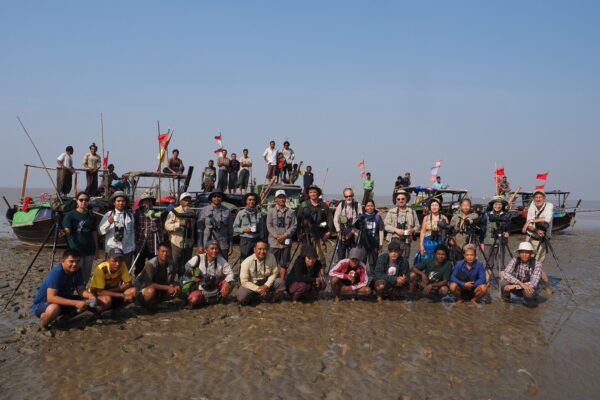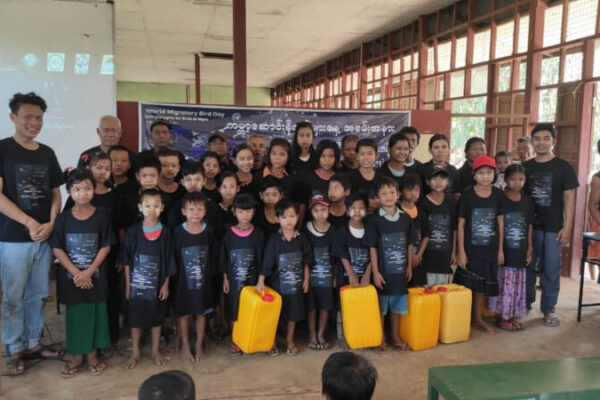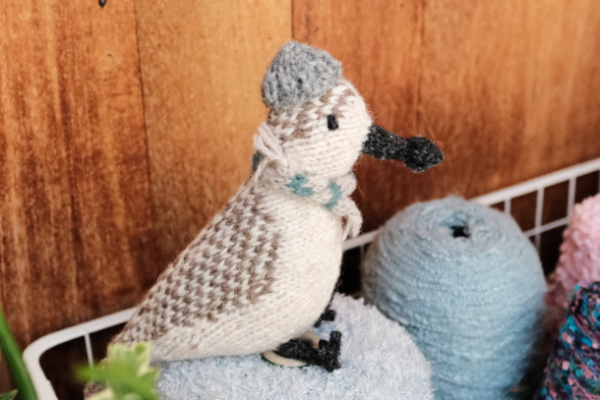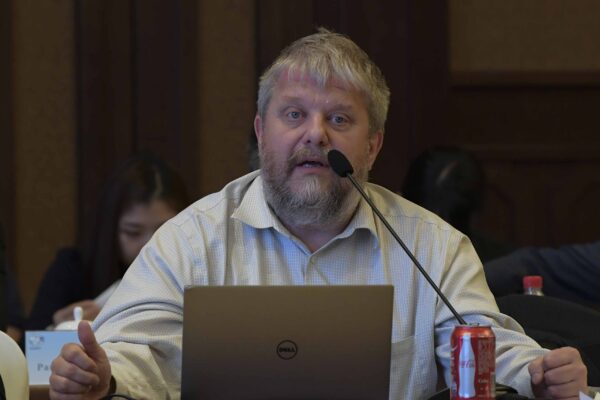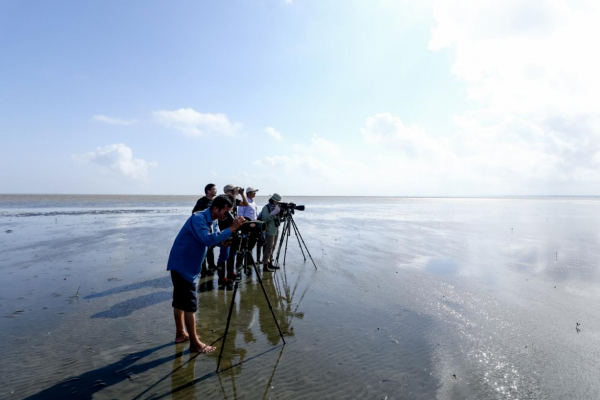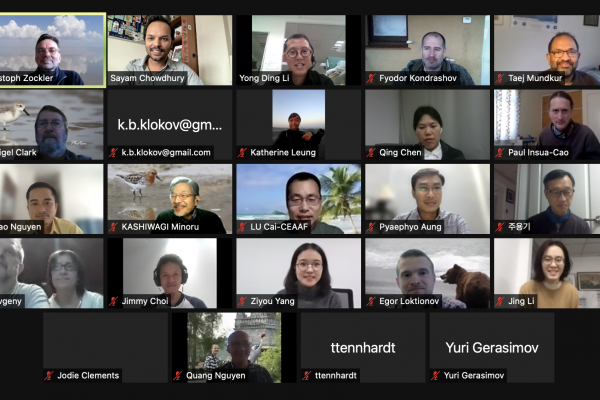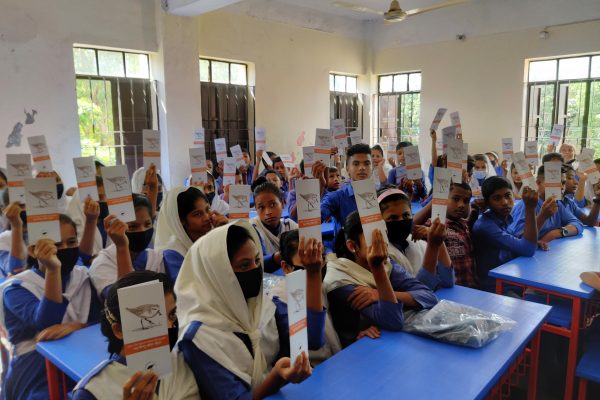-
Conservation of Spoon-billed Sandpiper in the Gulf of Mottama and Tanintharyi Coastal of Myanmar
EAAFP Small Grant Fund Project by Pyae Phyo Aung, Shane Thu Lwin and Thura Soe Min Htike Nature Conservation Society – Myanmar (NCS) LCG members are looking the spotting the scope and binocular during the bird watching training © Nature Conservation Society – Myanmar Participation of local communities in conservation is crucial for long-term conservation management. Two local Conservation Groups(LCGs) newly established in The Tanintharyi region are improved their conservation skills through five consecutive bird-watching training sessions. Two LCGs from the area of the Gulf of Mottama are also trained to elaborate their bird-watching, patrolling and conservation skills. Vinyl billboards were installed in the public areas of Myeik and Boke Pyin to raise the awareness of the conservation of migratory shorebirds during their wintering season. This year, 2021-2022 a total of nine national surveyors conducted an annual wintering census survey of Spoon-billed Sandpiper and migratory shorebirds at the Gulf of Mottama and Tanintharyi coastal accompanied by the LCGs members. For the Gulf of Mottama Ramsar site, the survey team covered upper Gulf located in east coastal where recorded 17 and estimated 80 critically endangered Spoon-billed Sandpiper (SBS), based on the SBS proportion in 173 flock counts of over 34,914 birds extrapolated to an estimated 160,000 birds of small waders in the area. These birds were encountered by the team at low tide feeding and widespread across the vast mudflat habitats. Former hunters of the Local Conservation Groups (LCGs) joined the survey and guided the survey team onto the small wader flocks. They were trained and informed about the survey techniques, biology and significance of the species in a regional, national and global context. Providing binoculars to LCG team © Nature Conservation Society – Myanmar Survey team members with LCG at the Gulf of Mottama © Nature Conservation Society – Myanmar Three sites located at the North of Myeik mudflat, recorded ten globally threatened species such as Nordmann’s Green Shank, Great Knot, Chinese Egret, Black-headed Ibis, Bar-tailed Godwit, Black-tailed Godwit, Eurasian Curlew, Curlew Sandpiper, Red-necked/Little Stint and Red-breasted Parakeet. Three sites located at the Bokepyin mudflat, recorded twelve globally threatened species such as single Spoon-billed Sandpiper, Black-tailed Godwit, Bar-tailed Godwit, Eurasian Curlew, Nordmann’s Greenshank. During the project implementation period, NCS keep communicating with the existing LCG members in the Gulf of Mottama for the conservation actions and formation the new LCG team at Tanintharyi coastal region. Tanintharyi costal region is also important for migratory water birds and needs to be conserved as a legal flyway network site or Ramsar Site. Moreover, the NCS team is coordinating with Tanintharyi region Forest Department for the Spoon-billed Sandpiper conservation activities and introducing Tanintharyi coastal as a new flyway network site. Discussion between NCS and Officers from Forest Department for shorebird conservation, Tanintharyi Region via Zoom on 30 November 2021© Nature Conservation Society – Myanmar The project was funded through the 2021 EAAFP WG/TF Small Grant Fund. View the report, Click here.
Continue reading -
2023 Spoon-billed Sandpiper Census in the Gulf of Mottama, Myanmar
Survey team of 2023 Spoon-billed Sandpiper Census in Myanmar in January 2023 © Spoon-billed Sandpiper Task Force For the twelfth consecutive year the Nature Conservation Society- Myanmar (NCS) in close collaboration with the Spoon-billed Sandpiper Task Force (SBS TF) organised the Spoon-billed Sandpiper winter survey and waterbird monitoring expedition. The Gulf of Mottama Ramsar Site is a hugely important intertidal mudflat in Myanmar hosting thousand of migratory waterbirds including the critically endangered Spoon-billed Sandpiper and supporting local people’s livelihoods such as fishery. The Spoon-billed Sandpiper Task Force and its local partner have carried out annual shorebird monitoring surveys at the Gulf of Mottama over the last 15 years. However, due to the Covid-19 pandemic impact the 2020-2022 surveys were carried out without any international participation. In 2023 (NCS) organised a total of 20 surveyors from China, Russia, Thailand Germany, US and Myanmar, who were accompanied by 40 local boat crew who have been surveyed the East (Mon State) and West (Bago Region) of the Gulf of Mottama for 5 days between 20-25 January 2023. Local experts were trained to the Local Conservation Group members during the survey period for basic birdwatching, and flock scanning that will help for future citizen science surveys. Overall preliminary results of the total small wader population in significantly decreased to approximatelyonly 60000 which is one-third less than in previous years. Further analysis is still ongoing, but sadly, the Spoon-billed Sandpiper has also declined and is estimated based on flock count to less than 20 individuals. According to the local fishermen information hunting is now resuming in some places in the Gulf of Mottama area and stronger law enforcement is needed. The survey was generously supported by the Mangrove Conservation Fund Shenzhen (MCF), the International Union for Conservation of Nature (IUCN) through the Gulf of Mottama Project and the Manfred-Hermsen Foundation, Germany.
Continue reading -
Celebrating 2022 World Migratory Bird Day in Villages near the Gulf of Mottama, Myanmar
Group photo of the participants to the WMBD 2022 at GoM ©️ NCS On 10 May 2022, Nature Conservation Society-Myanmar (NCS) organized the World Migratory Bird Day(WMBD) event for 2022 in Basic Education Primary School, Koe Tae Su Village, Belin Township near Gulf of Mottama(GoM) in Myanmar with financial support from EAAFP WMBD Small Grant Fund. The purpose of organizing this event was to raise awareness in local communities on how WMBD was formed and held annually all around the world, and to educate the local communities about the importance of the conservation of migratory birds and wetland ecosystems. A total of 104 participants joined the event and most of participants were school students and local communities from villages around GoM. Members of Local Conservation Groups (LCG) from Koe Te Su village have also joined the event. Presentation on WMBD and the theme, Light Pollution©️ NCS The event started with visual presentations about the history of WMBD, annual celebrations, the theme of this year - light pollution, and migratory shorebirds, wetland conservation and Ramsar sites were presented. The “Migratory Bird” song and video clips of the six EAAFP Flyway Network Sites in Myanmar and light pollution were shown. The team presented the mangrove forest status and its conservation in Myanmar. Quiz and games were included in the event with an online platform, covering the critically endangered Spoon-billed Sandpiper (SBS), light pollution and migratory birds. the. Questions were shown on the screen and participants were encouraged to the answer quickly. The participants whowere the first to answer correctly won prizes. School students aged between 5 and 10 played the Spoon-billed Sandpiper (SBS) finding game and kids who could find the greatest number of SBS were awarded. Kids playing the Spoon-billed Sandpiper finding game ©️ NCS Awarding participants who could answer the quiz ©️ NCS Local communities and students were more aware of the theme of WMBD for this year especially the value of the natural dark, increasing light pollution, the impacts of the light pollution on migratory birds and nocturnal animals. They also learned about the six Ramsar sites in Myanmar and their importance in their livelihoods. Participants have also observed the conservation status of the threatened species including the Critically Endangered Spoon-billed Sandpiper that migrate to the Gulf of Mottama and the efforts of local and international organizations working for the conservation. The audience were fascinated by such a little bird to migrate over thousands of kilometres. They were aware that the migratory birds are fully protected under Myanmar Conservation of Biodiversity and Protected areas Law. Participants enjoyed the songs, presentations and videos, had fun during the quiz and game session. T-shirts with the 2022 WMBD global poster printed on the front were distributed to the participants as souvenirs. Participants during the Presentation on the Conservation of Migratory Birds and Wetlands ©️ Nature Conservation Society-Myanmar Article prepared by Nature Conservation Society-Myanmar (NCS).
Continue reading -
At the Nakdong Estuary FNS, river flowing freely for the first time in 35 years
Sitting in the River mouth of Nakdong River, one of the largest rivers in RO Korea, Nakdong Estuary Flyway Network Site (EAAF097, SIS), located in Busan Metropolitan City in RO Korea, has joined the Flyway Site Network since 2009. The Nakdong Estuary consists of sandy shores, estuarine waters, intertidal marshes, and artificial wetlands. There are internally endangered Chinese Egret, Oriental Stork, Steller's Sea eagle, Black-faced Spoonbill, and Eurasian Oysters in the Estuary. The Nakdong Estuary Embankment was built in 1987 to secure agricultural, industrial, and drinking water by preventing from mixing of fresh and salty water. On the other hand, the bank has degraded water quality, the environment, and the ecosystem of the estuary. There has been a long discussion on opening Nakdong Estuary Bank’s floodgate for 35 years. One of the previous discussions was introduced on the EAAFP website (click here). Eulsukdo near the bank is one of the important sites for migratory birds. Especially in the mid-80s, a lot of swans and geese visited the site every year. This site used to be productive on plankton, shellfish, crabs, and fish to accommodate these visiting waterbirds. However, after the completion of the estuary bank, the number of waterbirds has drastically declined to only about 5-10% of the numbers recorded in the 1990s. At the Nakdong Estuary Eco Center © EAAFP Secretariat In the end, the floodgate of the bank (W 2,400m x H 18.7m) has been fully opened since 18 February 2022. This is based on the research work from 2017 to 2021, comparing the effect on the number of fish species between flowing and closed water bodies in the estuary. After the decision and its implementation by the RO Korean government, EAAFP Secretariat staff including Ms. Hyeseon Do, Ms. Yeonah Ku, and Ms. Hyoeun Kim visited the FNS from 21 to 22 February 2022 to meet conservationists and staff from local environmental NGOs, research institutes, and government officials to encourage this important project of wetland restoration. Understanding the importance of what recently happened at the Nakdong Estuary FNS, officers from the EAAFP Secretariat visited the Nakdong Estuary Flyway Network Site. Group photo with Wetlands and Birds Korea © EAAFP Secretariat They visited the office of Wetlands and Birds Korea (WBK), an environmental organization that worked for the conservation of birds and wetlands at the Nakdong Estuary since 2000. Mr. Junerog Park and Mr. Sihwan Kim from WBK informed the trend of birds population and the constructions issues at the Nakdong Estuary. Busan Metropolitan City has been planning to build more than the existing 10 bridges (including two bridges for subways) across the Nakdong Estuary. Furthermore, its monitoring results were discussed with other organizations out of RO Korea, which they used to share with the Australasian Wader Study Group. It was touching to hear that they had felt connected when had heard from other bird watchers from Australasia first time and; also their thoughtful care on decreasing bird populations, especially the Spoon-billed Sandpiper in Nakdong be broadly recognized. Meeting with Professor Joo © EAAFP Secretariat The next stop was the Freshwater Ecology Lab of Pusan National University. Prof. Geajae Joo gave a presentation on the status of the Busan Eco-city and Eulsuk Island. The researchers and Professor Joo from the lab were involved in the research which supported opening the water gate of the Nakdong Estuary Bank. Thanks to the meeting, the team could understand more about the perspective of the government and public corporations of Ro Korea on river management of the site. Meeting at the Nakdong Estuary Eco center © EAAFP Secretariat At the Nakdong Estuary Eco Center in Eulsuk Island, we had a meeting on the core protected area of the island and the potential FNS manager workshop in 2023, with Dr. Nial Moores from Birds Korea and the director of the Eco Center. Dr. Nial Moores was involved in designing the core area and the center in the early phase, with Prof. Geajae Joo’s team. After that, Dr. Hyunwoo Kim guided the center and Eulsuk Island Ecological Park. they had a conversation on the management of the core area and the center for planned renovation. The natural flow of the Nakdong River and its effects should be carefully considered, which could encourage other rivers/ estuaries’ ecological restoration. All the effort and passion of the conservationists and researchers who worked for the estuary will pay off, hopefully in the near future.
Continue reading -
“Flyway: connecting people and migratory waterbirds” Story Series #15 – Interview with Ms. Inyoung Kim, textile artist raising awareness of conservation of Spoon-billed Sandpiper
In this issue of Flyway Story, we invited Ms. Inyoung Kim, textile artist from the Republic of Korea, to share with us how her artwork links with the conservation of migratory waterbirds, especially Spoon-billed Sandpiper. “I’m grateful that I can be a part of the starting point to communicate about wildlife conservation with others.” – Ms. Inyoung Kim Ms. Kim is designing her work ©Inyoung Kim / wonderwall EAAFP: What are you currently working on? Currently, I am preparing for the fourth book with like-minded people about knitting and crochet. I am also working on an overseas magazine, which is still ongoing. It is a project to let my readers follow my design instructions to make their own artwork. Another work is about Spoon-billed Sandpiper that I want to continue, so I am still working on it. I also have a plan to hold a private exhibition, but there are not many things to explain in particular since this is at the beginning phase. EAAFP: What do you want to achieve through your artwork? Well, it is quite a difficult question. Actually, I am immersed in craft art because I like the process itself more than any other purpose. I am still learning about the field. However, I believe that as I continue to do various craftworks, I can understand myself more and comfort others through my artwork, which enables communication with others. Ms. Kim is working on knitting ©Inyoung Kim / wonderwall EAAFP: Why did you choose textile art as a method to raise awareness of endangered species? The biggest reason is that textile art is my best means of communication, but at the same time, I see fiber is close to our daily lives in the context of ‘protection’. I thought that the works made of these fibers would lead to warm and emotional consent for species that need protection. Also, due to the characteristic of textile art, it takes a lot of time to work. Therefore, in an era where everything is fast and instant, I thought that it could be a good means to let participants spend some time to think carefully about a topic for a while. EAAFP: One of your project patterns is Spoon-billed Sandpiper. Can you tell us why you chose this species among many other endangered birds? First of all, from a personal point of view, the characteristic beak was beautiful. Also, during the investigation, I found it pity that the number of this small but strong migratory waterbird has plummeted for several reasons. I wanted to initiate a public conversation about the bird before we lose them without knowing them. ©Inyoung Kim / wonderwall EAAFP: What are your future plans or ambition to raise awareness of the conservation of endangered animal species? I would like to continue working on projects as much as possible in my own capacity. I'm grateful that can be a part of the starting point to communicate about wildlife conservation with others. Thank you. For more about Kim In Young’s Spoon-billed sandpiper knitting project Learn more about EAAFP’s work on Spoon-billed sandpiper Support Spoon-billed Sandpiper
Continue reading -
In memory of Dr. Evgeny Syroechkovskyi, Representative of the Russian Federation to EAAFP and Chair of Spoon-billed Sandpiper Task Force (18 May 1968 – 25 January 2022)
It is with deep sadness that the EAAFP Secretariat received the news…
Continue reading -
Spoon-billed Sandpiper Conservation Alliance 2021 Annual Meeting
Reported by Spoon-billed Sandpiper Conservation Alliance Secretariat On November 20, the Spoon-billed Sandpiper Conservation Alliance 2021 Annual Meeting was held in Zhanjiang, Guangdong, China. More than 50 people attended…
Continue reading -
Spoon-billed Sandpiper Task Force meeting 2021
Drafted by The Spoon-billed Sandpiper Task Force The Spoon-billed Sandpiper Task Force of The East Asian-Australasian Flyway Partnership (EAAFP) completed a two-days online meeting between 24 and 25 November…
Continue reading -
World Migratory Bird Day 2021 Oct Event – Bangladesh (Bangladesh Spoon-billed Sandpiper Conservation Project)
©️ Bangladesh Spoon-billed Sandpiper Conservation Project/BSCP Event Title: Shorebird conservation campaign Event date: 27-28 October, 2021 Event Site: Sonadia…
Continue reading



